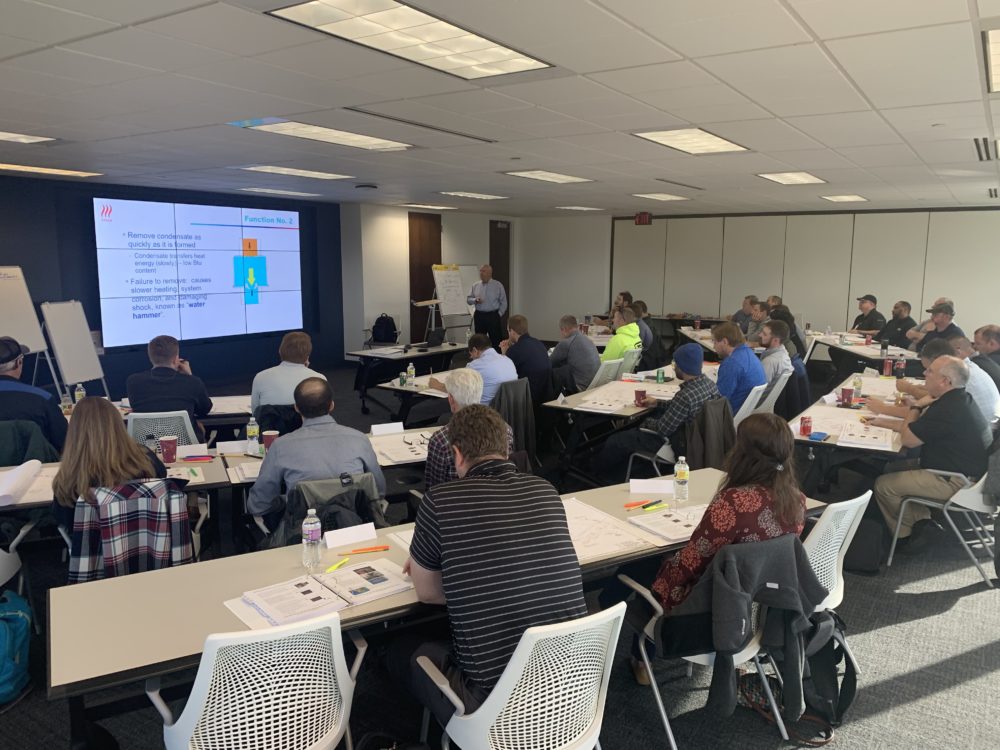Steam System Engineering, Operations and Design Training – Two Day Training

Click Here For Information on the Training
Steam System Engineering, Operations and Design TrainingтTwo Day Program
(CEU Credits)
- April 18th and 19th
Or
- October 3rd and 4th
at Cleaver-Brooks “New Training Facility”
Milwaukee, WI Location
$ 780.00 per person
- All training materials
- In-depth training manual
- Lunch each day
- Contact: harwood@invenoeng.com for more information
- Or, call 239-289-4498
Cleaver-Brooks and Inveno Engineering, LLC are teaming up to deliver an exciting two-day Steam System Engineering Design and Operation Training on April 18th and 19th at Cleaver-Brooks Training Facility in Milwaukee, WI.
Our companies use a Steam Team Group concept where the attendees work in teams of two or three people as a training team. Our instructors will provide the knowledge and demonstrate the knowledge to the class using specially designed “Steam Training Prints”. The training teams will work with the steam training prints and complete tasks to exercise and retain the acquired knowledge.
The Steam Team Group Concept is to insure maximized comprehension of the training course.
Our senior field instructors are available at any time to go into further detail on any subject matter that the attendees would like. Attendees will also receive an in-depth training manual to refer back to in the future.
- COURSE SYLLABUS:
Introductions
- Steam Overview
- General overview
- How to calculate Btu usage
- Understanding the vapor
- Superheat
- Benefits
- Superheat production
Tasks:
- Equipment Btu calculations
- Understanding equipment steam requirements
Steam Tables - Understand the steam tables
- Appling steam tables
- Engineering
- Design
- Problem-solving
- Flash Steam
- Why flash occurs
- Effects on the system
- Calculating the flash percentage
Tasks:
- Using tables to determine the quantity of flash steam
- Calculations on energy losses when flash steam is not recovered
– Flash Steam RecoveryRecovery system - How to manage flash steam generation
- Different flash steam operating systems
- When to recover and how to recover
– Advantages and disadvantages of each type of recovery system - Flash tank sizing
Tasks:
- Implementing a flash recovery system on a modulating system
- Implementing a flash recovery system on a non-modulating system
– Steam quality
– What is steam quality
– Effects on the process operation and other steam components
– How to quantify and test in the field
– What are the calorimeters that are available for testing
– What are the necessary steps to improve the steam quality
Tasks:
- Review steam quality testing procedures
- What are the testing points for steam quality
- Boiler Designs to Provide High Steam Qualit
- Firetube and Watertube boiler designs
- Boiler steam space and why that is important
- Types of steam separations in the different boilers
- Steam generators and steam quality difficulties
- What are the boiler steam quality testing methods
- How to improve boiler steam quality
Tasks:
- Review boiler prints for testing points for steam quality
- Boiler Combustion Testing Methods
- Typical combustion analysis
- Understanding Fuel air ratio curves
- Impact of combustion tuning on system performance
Tasks:
- Review combustion testing sheets
- Plot fuel-air ratio curves
- Deaerator Operation – Why it is Critical to the Steam System
- The science of deaeration
- Benefits of deaeration
- Types of deaerators and feed systems
- Deaerator controls
- Dissolve oxygen testing (7ppb)
- Steam control
- Pump control
- Level control
- Boiler Heat Recovery
- Energy losses in a boiler plant
- How to recover losses
- Economizer
- Condensing economizer
- Blowdown heat recovery
- Flash tanks
- Hidden losses
- Boiler plant ventilation
- Water quality
- Boiler room insulation
Team Tasks:
- Review boiler prints
- Develop heat recovery projects
– Steam and Condensate Systems - Overview of the codes
- Sizing a steam line properly
- What are the acceptable steam velocities
- Installation best practices for steam lines
- Connections (overview of each type)
- Condensate removal from steam lines
- Materials for the different steam systems
- Overview of condensate line installation
- What are the different types of condensate systems
- How properly size a condensate line
Team Tasks:
- Steam line condensate removal
- Steam line air venting
- Sizing process steam lines and non-process steam lines
- Installation of condensate lines
- Sizing of condensate lines
- Steam Valves
- Overview of all valves used in steam
- Operational design
- Where to use what valve for what application
Team Tasks:
- Review and do CV calculations
- Selecting the correct valve arrangement
- Develop an installation detail
- Review different applications
- Condensate Recovery Systems (Tanks and Pumping Systems)
- Why return condensate
- Reduce emissions
- Optimization
- Reduction of energy
- How to calculate for condensate recovery
- Different condensate pump unit types
- Advantages and disadvantages
- Operation
- Sizing condensate tanks
- Why is NPSH so critical
Team Tasks:
- Sizing a condensate pumping system
- Selecting the proper condensate tank unit for a system
- Design of a condensate tank system
- Sizing NPSH for the pumping units
- Steam Trap Stations
- What are the functions of the steam trap?
- Types of steam traps
- Steam trap operation
- Selection process
- Sizing process
Team Tasks:
- Selecting a steam trap for two different applications
- Sizing steam trap for the applications
- Testing methods
– Control Valves - Application in the steam system
- Selection process
– Types of steam valves
– Turn down - Installation considerations
Team Tasks:
- Size a pressure let down station
- Size control valve for heat exchanger
- Waterhammer
- Overview of waterhammer
- Five types of waterhammer
- Different causes of waterhammer
- Solutions to waterhammer
Team Tasks
- Review installation training print and determine waterhammer locations
- Waterhammer problem prints – teams to resolve the waterhammer










